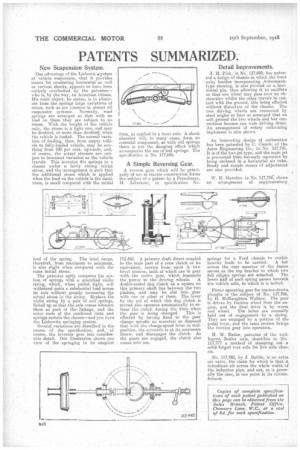PATENTS SUMMARIZED.
Page 22

If you've noticed an error in this article please click here to report it so we can fix it.
New Suspension System.
One advantage of the Liehowrieszystem of vehicle suspension, that it priivides means for countering horizontal as well as vertical shock*, appears to have been entirely overlooked. by the patentee— who is, by the way, an American citizen. His main object, he states, is to eliminate from the springs large variations of stress, such as are common in almost all suspension systems. Normally, road springs are arranged so that with no load on them they are subject to no stress. With the weight of the vehicle only, the stress is a light one, and may be doubled, or more than doubled; when the vehicle is loaded. The normal variation of loading, then, from empty vehicle to fully-loaded vehicle, may be anything from 100 per cent. upwards, and, of course, the actual stresses are subject to incessant variation as the vehicle travels. This inventor fits springs to a chassis under a fairly strong initial stress, and the arrangement is such that the additional stress which is applied when the load on the vehicle is the maximum is small compared with the initial
load of the spring. The total range, therefor, from maximum to minimum, is also slight when compared with the same initial stress.
The patentee aptly compares his eys. tern of springs with a stretched violin string, which, when pulled tight, will withstand quite a substantial load across its axis without .greatly increasing the actual stress in the string. Replace the violin string bk a pair of coil springs, linked up so that the axle comes between them as part of the linkage, and the outer ends of the combined links and springs sustain the chassis—and you have the Liebowitz springing system.
Several variations are described in the course of tho specification, and, of course, the inventor, goes into considerable detail. Our illustration shows one view of the springing in its simplest form, as applied to a front axle. A shock absorber will, in many cases, form an essential component, as with coil springs there is not the damping effect which accompanies the use of leaf springs. The specification is No. 117,665.
A Simple Reversing Gear.
A reverse gear which will be principally of use in tractor construction forms the subject of a patent by a Frenchman, M. Letroteur, in specification No.
113,445. A primary shaft direct coupled to the male part of a cone clutch or its equivalent, carries loose, upon it two bevel pinions, both of which are in gear with. the crown gear, which transmits the, power to the 'driving wheels, A double-ended dog clutch on a square on this primary shaft lies between the two pinions, and may be slid ' into , gear with one or other of them. The lever by the aid of which this dog clutch is moved also operates automatically to releas.e the clutch, during the time when
the gear is being changed. This is effected by having fixed to the gear change spindle an eccentric so disposed that with the change-speed lever in midposition, the eccentric is at its maximum throw, and disengages the clutch. As the gears are engaged, the clutch also comes into use.
Detail Improvements.
J. H. Pick, in No. 117,699, has patented a deSige of chassis in which the front axle, besides incorporating Ackermanntype steering, is also pivoted on a horizontal pin, thus allowing it to oscillate so that one wheel may pass over an obstruction whilst the oilier travels in eontact with the ground, this being effected without distortion of the chassis. Tho two driving wheels are connected by steel angles or bars so arranged that on soft gsound the two wheels and bar connections become one wide driving drum. An arrangement, of rotary cultivating implement is also shown.
An interesting design of carburetter has been patented .by C. Clench, of the Aster Engineering Co., in Nn. 117,741. It is of the two-jet type, and the main jet is prevented from too-early operation by being enclosed in a horizontal air tube. Ready and simple means of adjustment are also provided.
W. H. Marsden, in No. 117,706; shows an arrangement of supplementary springs for a Ford chassis to enable heavier loads to be carried. A bar across the rear member of the frame serves as the top bracket to which two full elliptic springs are attached. The lower half of each spring passes beneath the vehicle axle, to which it is bolted.
• . Power operating gear for tractor-drawn plonehs is thesubject of No. 117,766, by D. McNaughton Wallace. The gear is driven by friction wheel from the engine, and the final drive is by worm
and wheel. The latter are normally held out of engagement by a aiming. They are engaged by a portion of the pedal lever, and the same motion brings the friction gear into operation.
. H. M. Butler, patentee of the wellknown Butler axle, describes in No. 117,777 a method of stamping out a solid forged rear axle for live axle chase sis.
No. 117,782, by J. Bernie, is an extra air -valve, the claim for which is that it introduces air across the whole width of the induction pipe, and not, as is generally the case, at ono point inits circumference.






















